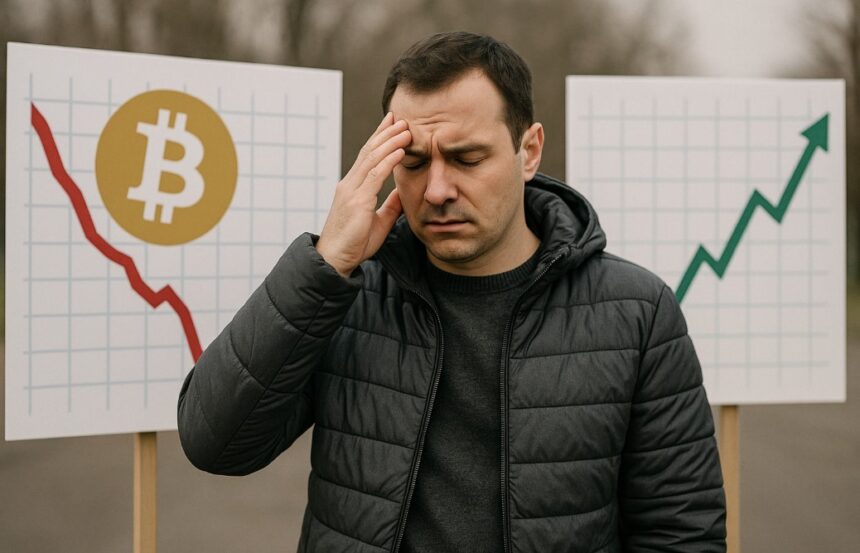The recent drop in Bitcoin (BTC) to around $95,000 is causing concern among market participants. This pullback, which deepens the correction that began several weeks ago, begs the question of whether it is the start of a long bear cycle (crypto winter) or simply a correction within a broader trend.
The price trend shows that Bitcoin has lost the high levels reached between September and October, when it exceeded USD 120,000. And it is now retreating back toward the region observed more than six months ago.
The graph below shows a series of highs and declines since early November. it strengthens the sense of caution among investors.
However, for some analysts, this kind of movement is not enough evidence to talk about a “crypto winter.” But it is a natural stage in market dynamics.
Javier Esparza: “Nothing about crypto winter”
Speaking to CriptoNoticias, Spanish analyst Javier Esparza Peribañez denied that the correction represented a significant change in trend. “In my opinion, this is just a correction in an upward trend that is still holding,” he says. To support this vision, he points out several factors that he considers decisive in the current scenario.
Espaza highlighted that the market capitalization of cryptocurrencies increased by 16.4% in the third quarter of 2025, which in his opinion indicates that: Structural growth in the sector remains intact.
He further added that “global cryptocurrency adoption data continues to show growth,” and emphasized that from an institutional perspective, “cryptocurrencies are increasingly integrated into traditional financial systems, and very high trading volumes are expected in the near term.”
Among the most impressive elements, he mentions developments related to new financial products. “For XRP alone, we plan to approve 13 exchange-traded funds (ETFs) in November,” Espaza said.
He then highlighted the performance of the XRP ETF issued by Canary, which set an inflow record with its listing on the US stock market on November 13th. As shown below, a total of $58.5 million flowed into this investment product on the first day.
In their view, this is a sign of the system’s maturation and growing interest from large investors.
For this reason, he asserts that there is “absolutely nothing about a crypto winter.” In your reading The market may be waiting for a catalyst It improves the overall feeling.
One of these will be changes in US monetary policy due to the reopening of the federal government. In his view, the resumption of federal operations in the United States “could trigger a change in market sentiment.” “Especially when it comes with institutional funding that generates increased endowments,” he comments.
Espaza also warns of typical market behavior during bear cycles. It is “so far bear market No clear bull run in advance for altcoins (alt season). ”
“And to this day, nothing like the latter has happened,” he comments. And that’s even though Blockchain Center’s Altseason Indicator briefly showed signs of a possible altcoin season coming this year, as seen below. Trend failed to strengthen or maintain clear momentum Among those assets.
Emmanuel Juarez: “Such episodes usually bring opportunities”
A different vision, though not necessarily bearish, comes from Argentine trader and technical analyst Emmanuel Juarez. Those who are looking more closely at their current setbacks.
Juarez suggested that Bitcoin’s decline and the market were, in part, a reaction to global tensions heightened by Michael Barry’s warning of a potential tech bubble. Also, because the Federal Reserve’s decision on December 10th was unpredictable.
The expert adds the additional factor of a lack of recent macroeconomic data due to the extended U.S. government shutdown. “The scenario has worsened due to the lack of macro data (inflation and employment),” he said, highlighting the lack of key information to assess the state of the economy. This increases investors’ nervousness.
Nevertheless, Juarez believes that: These types of episodes may represent an opportunity “For those who analyze the market with a medium-term approach.”
But he also warned that weakness will continue as long as external instability persists: “Unless the technology sector regains momentum and the Federal Reserve’s position becomes clearer, the broader market may continue to correct, and Bitcoin is not exempt from that movement.”
Regarding recent price trends, Mr. Juarez emphasizes: Key areas that may serve as areas of support or interest.
“The initial purchase range is between USD 98,000 and USD 97,000, which is an area where we have historically seen demand.” Details. And he added an even deeper level. “Further down, a related support area is observed between USD 84,000 and USD 80,000, and a deeper correction could reinvigorate buying interest.”
These support zones are best seen on the following technical chart provided by an analyst.
What do you expect from Bitcoin and cryptocurrencies?
Both experts agree that the current setback cannot yet be interpreted as a confirmed change in the cycle. Bitcoin’s chart shows a decline from its associated highs, but suggests it remains within the broad range that has prevailed for much of the year. Recent actions are consistent with previous remedial steps.
It is this combination of technical structure, macroeconomic expectations, and institutional adoption developments that will determine whether Bitcoin regains its previous momentum. If bearish pressure continues to dominate the market.
For now, the debate over whether a “crypto winter” has begun is still open. Ultimately, the evolution of the global economic environment and future monetary policy decisions in the United States We will be defining the direction of digital assets in the coming weeks.








